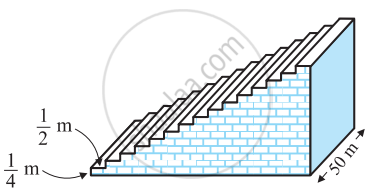Advertisements
Advertisements
Question
In an AP given a3 = 15, S10 = 125, find d and a10.
Solution
Given that, a3 = 15, S10 = 125
As an = a + (n − 1)d,
a3 = a + (3 − 1)d
15 = a + 2d ...(i)
Sn = `n/2 [2a + (n - 1)d]`
S10 = `10/2 [2a + (10 - 1)d]`
125 = 5(2a + 9d)
25 = 2a + 9d ...(ii)
On multiplying equation (i) by (ii), we get
30 = 2a + 4d ...(iii)
On subtracting equation (iii) from (ii), we get
−5 = 5d
d = −1
From equation (i),
15 = a + 2(−1)
15 = a − 2
a = 17
a10 = a + (10 − 1)d
a10 = 17 + (9) (−1)
a10 = 17 − 9
a10 = 8
APPEARS IN
RELATED QUESTIONS
How many terms of the A.P. 65, 60, 55, .... be taken so that their sum is zero?
Find the sum given below:
–5 + (–8) + (–11) + ... + (–230)
Show that a1, a2,..., an... form an AP where an is defined as below:
an = 3 + 4n
Also, find the sum of the first 15 terms.
In a potato race, a bucket is placed at the starting point, which is 5 m from the first potato and other potatoes are placed 3 m apart in a straight line. There are ten potatoes in the line.

A competitor starts from the bucket, picks up the nearest potato, runs back with it, drops it in the bucket, runs back to pick up the next potato, runs to the bucket to drop it in, and she continues in the same way until all the potatoes are in the bucket. What is the total distance the competitor has to run?
[Hint: to pick up the first potato and the second potato, the total distance (in metres) run by a competitor is 2 × 5 + 2 ×(5 + 3)]
A small terrace at a football field comprises 15 steps, each of which is 50 m long and built of solid concrete. Each step has a rise of `1/4` m and a tread of `1/2` m (See figure). Calculate the total volume of concrete required to build the terrace.
[Hint: Volume of concrete required to build the first step = `1/4 xx 1/2 xx 50 m^3`]

Find the sum of the following arithmetic progressions:
−26, −24, −22, …. to 36 terms
Find the sum of all integers between 84 and 719, which are multiples of 5.
The 4th term of an AP is 11. The sum of the 5th and 7th terms of this AP is 34. Find its common difference
Find four numbers in AP whose sum is 8 and the sum of whose squares is 216.
The sum of the first n terms of an AP in `((5n^2)/2 + (3n)/2)`.Find its nth term and the 20th term of this AP.
How many terms of the AP 21, 18, 15, … must be added to get the sum 0?
Find the sum of all natural numbers between 200 and 400 which are divisible by 7.
There are 25 rows of seats in an auditorium. The first row is of 20 seats, the second of 22 seats, the third of 24 seats, and so on. How many chairs are there in the 21st row ?
If the sum of first n even natural numbers is equal to k times the sum of first n odd natural numbers, then k =
If Sn denote the sum of n terms of an A.P. with first term a and common difference dsuch that \[\frac{Sx}{Skx}\] is independent of x, then
If a = 6 and d = 10, then find S10
Find the sum of numbers between 1 to 140, divisible by 4
The famous mathematician associated with finding the sum of the first 100 natural numbers is ______.
Which term of the AP: –2, –7, –12,... will be –77? Find the sum of this AP upto the term –77.
Which term of the Arithmetic Progression (A.P.) 15, 30, 45, 60...... is 300?
Hence find the sum of all the terms of the Arithmetic Progression (A.P.)
